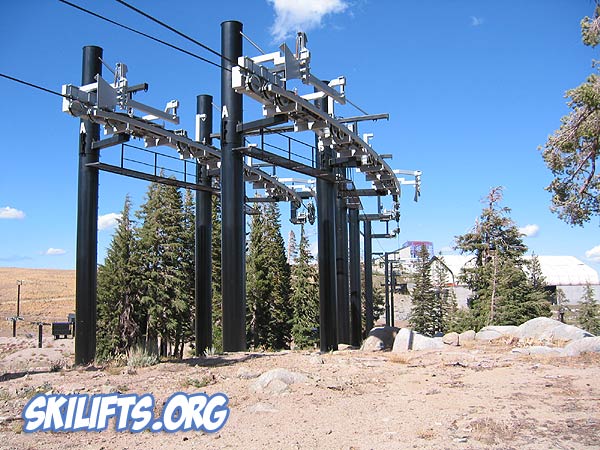
Ted wonders how a former Pulsed Gondola at Squaw Valley (seen here) manages to turn in both directions. Image via Skilifts.org.
Ted writes:
I wanted to tip you off to something I stumbled across the other day– you may already know about it, but on the off chance you don’t, I thought it was worth bringing up.
It seems Squaw Valley ski resort has (or actually, had — it got taken out this summer which is why i heard about it) a pulsed gondola that has a mid-path turn. The odd bit is that it seems it is NOT a detachable lift, but still manages to make a significant turn (looks like 20 degrees or so). I assume since it is pulsed that it slows down at the turn… but still I cant understand how this works. I’ve never heard of a lift that could turn in both directions without detaching.
I hope this helps you in some way (and id love to see a post on how the heck this is possible… it makes my head hurt trying to think about it).
Firstly, I want to say thanks to Ted for sending this along. I’m not sure we’ve ever encountered anything like this on The Gondola Project, and it’s well worth exploring.
While I don’t know for certain how a system such as this works, here’s my guess:
As we discussed last week, gondolas can turn corners but must do so on the outside/convex side of the corner. This is because the vehicle grips grab onto the rope from the outside of the rope. That means while a gondola can tackle the outside of a corner in the (for example) inbound direction, for the outbound direction it would have to tackle the corner on the inside of the corner – which is not technically possible.
Currently the solution to this problem is to make the inbound and outbound directions of a system ply different routes than one another with every single corner being either a right hand turn (assuming a clockwise rotation) or left hand turn (assuming a counter-clockwise rotation).
The only other way of dealing with this problem is to somehow switch the grip configuration in-station such that in the outbound direction the grip is then attached to the inside of the rope loop. But from what we know, such a technology doesn’t currently exist (though it may).
But this only goes for detachable gondolas. As you pointed out, this is a Pulsed Gondola system. As such, the cabins are fixed to the line – and have the ability to shuttle back-and-forth along the rope loop rather than circulate around the rope loop. Such motion would not be unlike an Aerial Tram configuration:

A circulating system (top) versus a shuttle system (bottom). Note: This image is not depicting how the Squaw Valley gondola would work. It's merely to demonstrate how vehicles circulate through a system or shuttle back-and-forth in a system.
Now let’s assume that on one side, the gondola is fixed on the outside of the loop and on the other side the gondola is fixed to the rope on the inside of the loop. Should the vehicles always shuttle back-and-forth (rather than circulate around) in the system, the gondolas will always be on the outside of corners.
Makes sense?

3 Comments
In the case of Squaw Valley gondola, I’d rather think that is possible to have turns both ways with fixed grips – it needs a special designed grip and a rather complex support (like that on picture)
Turns on detachable gondola were made -and used for dozens of years- already into the ’60 … look in this thread in Remonteès-mecaniques,net forum
http://www.remontees-mecaniques.net/forums/index.php?showtopic=7526
Neyret-Beylier , TCD-2 Betharram 1964? a 40° turn
Also in Switzerland there were/are gondola with turns , however all these equipment are costly to build and mantain, and on mountains where the line trace are virtually free, is easier to have two separated lines.
There are a few fixed-grip installations with shallow outside turns, using angled sheaves. The sheaves on both sides of the tower are angled 5 or 10 degrees from vertical, and the direction changes gradually over several such towers in a row. The cases I’ve heard about have been put in on existing lifts because they needed to move one of the terminals and didn’t want to move the entire lift.
I think your analysis of this lift is correct. If you look closely, you can see that the towers in the background are set up to support the left-hand line from the outside. Means you can have only two sets of cars, so capacity is even lower than that of a conventional pulse gondola.
So the image is of a tram and not a gondola since the cars don’t move around the bullwheel?